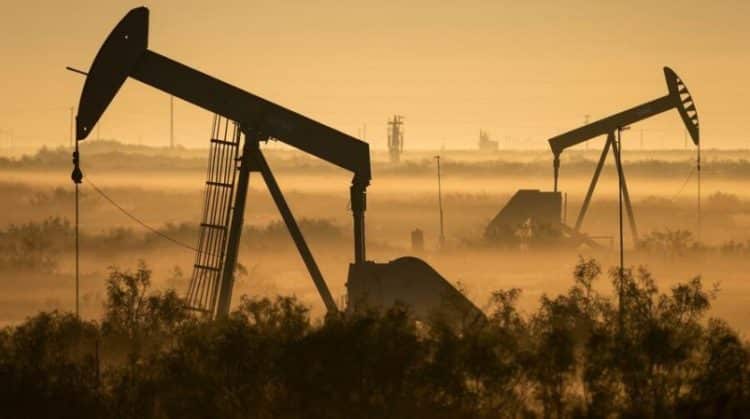The power struggle between Saudi Arabia and Russia on the oil market has caused the price of crude oil to drop as sharply as it has since the Gulf War in 1991.
The price war triggered by Saudi Arabia caused crude oil prices to plummet further at the start of trading on Monday night. The most important reference price, the North Sea variety Brent peaked by more than 30 percent to below $ 35 a barrel (around 159 liters).
The price of the US WTI grade also slipped by more than 22 percent to less than $ 32 a barrel. Crude oil has fallen 50 percent since its mid-January high. At the same time, currencies from oil-producing countries such as the Russian ruble, the Norwegian krone and the Australian dollar came under massive pressure.
With the sell-off , the oil markets are responding to Saudi Arabia’s state-owned oil company Saudi Aramco’s announcement last weekend that it will push its oil into the market with high discounts of four to ten dollars per barrel compared to the reference prices. In addition, Saudi Arabia had announced that it would increase oil production from the current 9.7 million barrels a day to over eleven million barrels a day from April.
The Saudis are targeting Russia with the oil spill: at the end of last week, the Russian oil minister Alexander Nowak had his Saudi counterpart Prince Abdulaziz bin Salman flashed off at a summit in Vienna with the demand that oil production be curtailed. The 24-state alliance of oil exporters, called “Opec +”, is thus de facto at the end.
An Opec + agreement expires at the end of March, setting production quotas for all Opec + countries. Together they represent around half of the world’s oil production. Because oil exporters will be able to produce as much as they want in the future, analysts expect the oil supply to skyrocket.
Collapse in oil demand
At the same time, however, the spread of the corona virus is weighing on the global economy. This has caused oil demand to collapse as sharply as recently during the financial crisis. A Goldman Sachs team led by chief strategist Jeff Currie wrote in an analysis on Sunday: “The price war between Opec and Russia has clearly started.”
From the Goldman Sachs analysts perspective, the situation is even more critical than in November 2014, the start of the recent price war launched by Saudi Arabia, “because it coincides with a collapse in oil demand for the corona virus.” Currie and his team therefore expect that the oil price will drop to an average of $ 30 a barrel in the second and third quarters. However, lows close to the $ 20 per barrel mark are possible.
Giovanni Staunovo, chief analyst for commodities at UBS, has a similar view . “The price of Brent should drop to $ 30 a barrel in the coming days and weeks,” he says. He expects prices to stabilize again at $ 40 in the second quarter. But for that, Opec and Russia would have to return to the negotiating table. So far, it doesn’t look like that.
The sell-off on the oil market could sweep expensive oil producers off the market in rows. Above all, they are likely to further exacerbate the crisis in the US shale oil industry. Many companies that manufacture in the Permian Basin, the center of the American oil industry, have financed their production growth through high debts. Many have raised capital through high yield bonds.
Pressure on Opec countries increases
But even before the failed Opec + summit in Vienna, the papers had come under pressure. Risk premiums for junk bonds from US energy companies skyrocketed to over nine percentage points. They are now likely to rise even further, pushing some US shale oil companies to the brink of bankruptcy. Even a broad sell-off in the market for American high-yield bonds no longer seems to be impossible. Oil companies make up around 15 percent of the entire American junk bond market.
However, the fall in prices is also likely to put a number of Opec countries under considerable pressure. On average, the Opec countries need an oil price of $ 90 for a balanced government budget, an analysis by the investment bank RBC Capital Markets shows. Crisis states like Libya, Nigeria or Venezuela are well over $ 150 a barrel. These countries could be further destabilized. But Iran, which is suffering from US sanctions, and Iraq, which has been going through a government crisis for months, could also be hit hard.
Should there be a longer phase with such low prices, the oil-producing countries would have to cut their budgets and raise more debt, warned Helima Croft, analyst at RBC Capital Markets. For countries that are particularly vulnerable politically and economically, the calculation could turn out to be bad.
However, low oil prices help importing countries, especially China and European countries, which are currently suffering from the effects of the corona virus. The low raw material prices could accelerate an economic recovery in these countries. Emerging countries such as India, Turkey and South Africa, which are dependent on oil imports, are also likely to be among the winners in development. In addition, it could allow ailing industries such as aviation to take a break.
The European Central Bank should also closely monitor the fall in oil prices. The central bank meets on Thursday to decide on a further cut in key interest rates. The fall in oil prices is likely to further depress the inflation rate in the euro area and could therefore force the ECB to take an interest rate move.

























